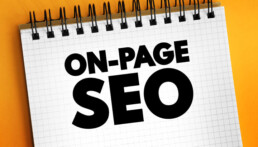On-Page Seo: Your Secret Recipe for Webpage Success
On-page SEO is like the secret recipe that makes a dish truly irresistible. It involves carefully selecting and combining various ingredients, cooking them to perfection, and presenting them in an appealing way. Similarly, on-page SEO requires meticulous attention to detail, strategic planning, and flawless execution to make a webpage stand out from the crowd.
In today’s digital age, having a website is no longer enough to attract visitors or generate leads. With millions of websites competing for attention online, it’s more important than ever to optimize your web pages for search engines and users alike. This is where on-page SEO comes into play.
By optimizing various elements of your website such as titles, headings, content, keywords, meta tags, and schema markup you can improve your search engine rankings and increase traffic to your site.
In this article, we will explore some best practices for on-page SEO that can help you achieve success in the world of digital marketing.

What’s Cooking in On-page SEO?
The current state of on-page SEO involves a variety of optimization techniques aimed at improving the visibility of web pages on search engine results pages (SERPs).
One critical aspect is ensuring that the content on web pages is relevant to users’ queries. This means incorporating keywords and phrases that align with search intent in titles, headings, meta descriptions, and body text.
Content relevance goes beyond mere keyword stuffing. It also entails providing value to visitors by delivering high-quality, engaging content that satisfies their needs and expectations.
A study by Backlinko found that pages with longer content tend to rank higher in SERPs than those with shorter content. Therefore, it’s essential to strike a balance between keyword usage and user experience when optimizing webpage content.
User experience also plays a vital role in on-page SEO success. Search engines prioritize websites that provide excellent user experiences such as fast load times, mobile-friendliness, ease of navigation, and engaging visuals, among other factors.
Thus, optimizing webpage content for both search engines and human readers is crucial for achieving high rankings in SERPs and driving organic traffic to websites.
Perfecting the Spices: Titles and Headings
Titles and headings play a crucial role in enhancing the visual appeal of a webpage, making it easier for visitors to navigate through the content. Proper formatting is essential for increasing readability and engagement on a webpage and can have an impact on search engine optimization (SEO).
Crafting catchy titles is also important as it helps to grab the attention of readers and entice them to click through to your page.
Using subheadings effectively is another key aspect of on-page SEO. Subheadings break up blocks of text into smaller, more manageable sections, making it easier for readers to consume the information. They also help search engines understand the structure of your content, allowing them to better index and rank your pages.
Incorporating keywords into headings is another effective way to improve your on-page SEO. By using relevant keywords in both titles and subheadings, you are signaling to search engines what your content is about. However, it’s important not to overuse or stuff keywords unnaturally into headings as this could lead to penalties from search engines.
With careful consideration and proper execution, incorporating keywords into headings can significantly improve your website’s visibility in search results.
Cooking up a Storm with Stellar Content
Crafting high-quality content is like creating a delectable dish, where every ingredient, from the research to the writing style, must be carefully selected and combined to provide a fulfilling experience for the reader. One crucial element of crafting engaging content is finding the right keywords or phrases that accurately reflect the topic while also appealing to search engines. Keyword research tools such as Google AdWords Keyword Planner or SEMrush can help identify relevant keywords with high search volumes.
Once you have identified your target keywords, it’s time to develop your recipe for enticing and informative content. This involves researching your topic thoroughly and organizing your ideas into a clear and logical structure. You should also consider incorporating multimedia elements such as images or videos to enhance engagement and break up dense blocks of text. By crafting an engaging narrative that incorporates relevant keywords throughout, you can create content that not only satisfies readers but also ranks well in search engine results pages (SERPs).
Presentation matters when it comes to optimizing images for on-page SEO. Images should be high quality, visually appealing, and optimized for web performance by compressing their file size without sacrificing image clarity. Additionally, including descriptive alt tags and filenames can help search engines understand what the image represents, further improving its chances of appearing in SERPs. By selecting appropriate images that complement your written content and optimizing them properly, you can enhance user engagement while also improving your website’s overall SEO performance.
Measuring success with analytics is like taste testing a dish; it helps determine whether all the ingredients are working together harmoniously or if adjustments need to be made. Tools like Google Analytics allow website owners to track user behavior metrics such as page views, bounce rates, time on page, and more. Analyzing this data can offer valuable insights into how users interact with your content and which areas may need improvement. By leveraging analytics data alongside keyword research insights and best practices in content creation and optimization, you can create a winning recipe for on-page SEO success.
Keyword Plating: Mastering the Art
Keyword plating is a crucial aspect of on-page optimization that involves strategically placing target keywords throughout the content to improve search engine visibility and drive organic traffic. While keyword research is the first step in the process, optimization techniques are equally important for achieving higher rankings in search engines. One must also consider search intent and analyze competitor tactics to ensure their keyword strategy is effective.
To master the art of keyword plating, it’s essential to conduct thorough keyword research to identify popular phrases relevant to your content. This will help determine which keywords to include and where they should be placed within your website copy. Additionally, understanding search intent can inform how you structure your content around those keywords.
For example, if someone searches for ‘how to bake a cake,’ they want step-by-step instructions rather than an overview of baking techniques.
Competitor analysis can also provide valuable insights into what works well within your industry or niche. By analyzing similar websites’ keyword strategies and identifying gaps in their content, you can tailor your own strategy accordingly. It’s important not to copy or plagiarize competitors but instead use their tactics as inspiration for creating unique, high-quality content that resonates with your audience.
Mastering keyword plating requires a combination of technical skills and strategic thinking. By conducting thorough research, optimizing effectively, considering user intent, and analyzing competitors’ tactics carefully, you can create compelling website content that drives organic traffic and boosts search engine visibility over time.
The Finishing Touches: Meta Tags and Schema Markup
Implementing meta tags and schema markup on a website can be likened to adding the final touches to a masterpiece painting, as they provide crucial information to search engines about the content of your website.
Meta description optimization is an important aspect of on-page SEO that involves crafting brief descriptions of a webpage’s content for search engines. These descriptions appear in search engine results pages (SERPs) below the title tag and URL, giving users an idea of what they can expect from clicking through to the page. By optimizing these descriptions with relevant keywords and compelling language, webmasters can increase click-through rates (CTR) and improve their website’s visibility.
In addition to meta description optimization, structured data is another critical component of on-page SEO. Structured data refers to the organization of information on a webpage using a specific format recognized by search engines like Google. By implementing schema markup – one type of structured data – webmasters can provide more detailed information about their content such as product reviews, business hours, or event dates.
This added context not only helps search engines better understand the content but also enhances user experience by providing rich snippets in SERPs. Implementing structured data can also increase CTRs by making your site stand out among other search results.
Overall, incorporating meta tags and schema markup into your website’s pages is vital for improving its visibility in search engine rankings. Optimizing meta descriptions with relevant keywords and strategic language helps attract more clicks from potential visitors while leveraging structured data provides additional context about your content that makes it more compelling for users searching online. The combination of these two techniques maximizes click-through rates and improves overall user experience, leading to increased traffic and higher engagement levels on your site.
Conclusion
In conclusion, it can be stated that on-page SEO serves as a crucial ingredient in the recipe for webpage success.
The optimization of titles and headings is an essential spice that flavors the content, making it more appealing to search engines and users alike. Providing high-quality content is like cooking up a storm; it requires skill, precision, and creativity. Keyword plating is another critical aspect of on-page SEO that needs to be mastered by website owners. It involves strategically placing relevant keywords within the content to improve search engine rankings.
The finishing touches of on-page SEO include meta tags and schema markup, which add depth and richness to web pages. These elements provide additional information about the content to search engines, making them more likely to display the page in search results.
In short, on-page SEO plays a significant role in enhancing website visibility, driving traffic, and improving user engagement. By following best practices for on-page optimization and continuously monitoring performance metrics, website owners can ensure their web pages remain at the top of search results pages – a surefire recipe for success in today’s digital landscape.
